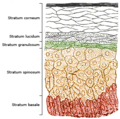- Stratum corneum
-
Stratum corneum 
Histologic image of human epidermis Latin stratum corneum epidermidis Gray's subject #234 1064 The stratum corneum (Latin for horned layer) is the outermost layer of the epidermis, consisting of dead cells (corneocytes) that lack nuclei and organelles. The purpose of the stratum corneum is to form a barrier to protect underlying tissue from infection, dehydration, chemicals and mechanical stress. Desquamation, the process of cell shedding from the surface of the stratum corneum, balances proliferating keratinocytes that form in the stratum basale. These cells migrate through the epidermis towards the surface in a journey that takes approximately fourteen days.[1]
Contents
Function
During cornification, the process whereby living keratinocytes are transformed into non-living corneocytes, the cell membrane is replaced by a layer of ceramides which become covalently linked to an envelope of structural proteins (the cornified envelope).[1][2] This complex surrounds cells in the stratum corneum and contributes to the skin's barrier function. Corneodesmosomes (modified desmosomes) facilitate cellular adhesion by linking adjacent cells within this epidermal layer. These complexes are degraded by proteases, eventually permitting cells to be shed at the surface. Desquamation and formation of the cornified envelope are both required for the maintenance of skin homeostasis. A failure to correctly regulate these processes leads to the development of skin disorders.[1]
Cells of the stratum corneum contain a dense network of keratin, a protein that helps keep the skin hydrated by preventing water evaporation. These cells can also absorb water, further aiding in hydration, and explaining why humans and other animals experience wrinkling of the skin on the fingers and toes ("pruning") when immersed in water for prolonged periods. In addition, this layer is responsible for the "spring back" or stretchy properties of skin. A weak glutenous protein bond pulls the skin back to its natural shape.
The thickness of the stratum corneum varies throughout the body. In the palms of the hands and the soles of the feet this layer is typically thicker, since these regions require additional protection in order to grasp objects and avoid injury. In general, the stratum corneum contains 15 to 20 layers of dead cells. The stratum corneum has a thickness between 10 and 40 μm.
In reptiles, the stratum corneum is permanent, and is replaced only during times of rapid growth, in a process called ecdysis or moulting. This is conferred by the presence of beta-keratin, which provides a much more rigid skin layer.
In the human forearm, about 1300 cells/cm2/hr are shed.
Skin disease
An inability to correctly maintain the skin barrier function due to the dysregulation of epidermal components can lead to skin disorders. For example, a failure to modulate the activity of kallikreins via the disruption of the protease inhibitor LEKTI causes the debilitating disorder Netherton syndrome.[3]
Additional images
See also
References
- ^ a b c Ovaere P, Lippens S, Vandenabeele P, Declercq W. (2009). "The emerging roles of serine protease cascades in the epidermis". Trends in Biochemical Sciences 34 (9): 453–463.
- ^ Haftek M, Callejon S, Sandjeu Y, Padois K, Falson F, Pirot F, Portes P, Demarne F, Jannin V. (2011). "Compartmentalization of the human stratum corneum by persistent tight junction-like structures". Exp Dermatol. PMID 21672033.
- ^ Descargues P, Deraison C, Bonnart C, Kreft M, Kishibe M, Ishida-Yamamoto A, Elias P, Barrandon Y, Zambruno G, Sonnenberg A, Hovnanian A. (Jan 2005). "Spink5-deficient mice mimic Netherton syndrome through degradation of desmoglein 1 by epidermal protease hyperactivity". Nat Genet 37 (1): 56–65. doi:10.1038/ng1493. PMID 15619623.
External links
- MedEd at Loyola medicine/dermatology/melton/skinlsn/stcorn.htm
- Histology at BU 08422loa - "Integument: thick skin"
Integumentary system (TA A16, TH H3.12, GA 10.1062) Skin Basement membrane zoneSkin fieldsHeadcampus frontalis, campus parietalis, campus occipitalis, campus temroralis, campus facialis (campus orbitalis, campus nasalis, campus oralis, campus mentalis, campus infraorbitalis, campus buccalis, campus zygomaticus)Neckcampus cervicalis anterior (campus submandibularis, campus caroticus, campus omotrachealis, campus submentalis), campus sternocleidomastoideus, campus cervicalis posterior (campus omoclavicularis), campus nuchalisChestcampus presternalis, campus clavipectoralis, campus pectoralis verus, campus mammarius, campus inframammarius, campus axillarisAbdomencampus hypochondriacus, campus epigastricus, campus abdominalis lateralis, campus umbilicalis, campus inguinalis, campus hypogastricusPerineumcampus analis, campus urogenitalisSubcutaneous tissue Panniculus/Pannus (Panniculus adiposus · Panniculus carnosus) · Stratum membranosum · Loose connective tissue · Superficial fasciaAdnexa Skin glandsSweat glands: Apocrine sweat gland · Eccrine sweat gland
SebaceousHair shaftArrector pili musclePilosebaceous unitHair sebaceous glandCategories:- Skin anatomy
- Dermatology stubs
Wikimedia Foundation. 2010.


